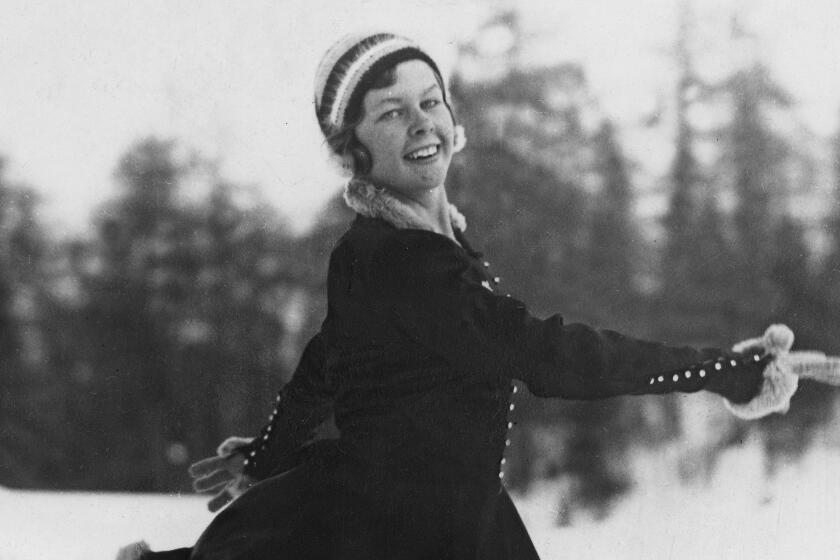On Top of the World : Pennel Fell Short in Olympics but Set 8 Pole Vault Marks
For the few athletes fortunate enough to win a gold medal, the Olympic Games can be the crowning achievement to an outstanding athletic career.
For those who don’t strike gold, they can be a disappointing low in a career otherwise filled with glory.
John Pennel of Agoura Hills is a member of the latter group.
Pennel, 52, set eight world records and tied another in the pole vault from 1963 through 1969, but he never won an Olympic medal.
He finished 11th in Tokyo in 1964 after injuring his back before the Games, and he placed fifth in Mexico City in ’68 when an archaic rule cost him a bronze medal.
“I just never had much luck when it came to the Olympic Games,” Pennel said. “I was injured in ‘64, and things just didn’t go my way in ’68.”
Don’t feel sorry for Pennel, however. It isn’t as if he has spent the last 24 years wondering about what might have been.
In fact, when Ukrainian Sergei Bubka attempts to win his second consecutive Olympic title in the pole vault today, Pennel will be off camping with his wife Caroline and their three children.
“I still follow track somewhat,” Pennel said. “But I’m not obsessed with it. I mean, I get interested in it leading up to the Olympics and world championships. It’s the same thing with baseball. I don’t watch many games during the season, but I do during the playoffs and the World Series.”
The second son of a farmer, Pennel spent the first 10 years of his life on a 360-acre spread in Memphis, Tenn., which produced everything from corn to eggplant to cotton to wheat.
He was introduced to the pole vault at 11 or 12 when he saw a newsreel about pole vaulter Bob Richards, the Olympic champion in 1952 and ’56.
“It just looked like a lot of fun,” Pennel said. “I remember thinking, ‘I can do that.’ ”
He got a chance to prove it during his sophomore year at Coral Gables (Fla.) High.
Pennel was waiting to hitch a ride home with his older brother after track practice when he saw some guys pole vaulting.
He wandered over to the pit, which in those days was nothing more than a pile of sawdust, and asked if he could give the event a try. The snickering group of boys, sure that Pennel would make a fool of himself, was only too happy to oblige.
He gave them what they were hoping for on his first attempt, plowing face first into the pit after failing to plant the front end of the aluminum pole in the pole vault box.
“They were just cracking up, rolling on the ground,” Pennel laughed. “I mean, I came up spitting sawdust.”
The laughter soon turned to silence when Pennel cleared the bar at 10 feet on his second attempt. The school record was 11-6 at the time.
Pennel raised his personal best to 13-9 and won the state title as a senior before choosing to attend the University of Florida.
His stay in Gainesville lasted only a semester, and he was driving a truck for his father’s welding company in Miami the following summer when Coach Lou Hertzog persuaded him to go to Northeast Louisiana University in Monroe.
“I had never been to Louisiana,” Pennel said. “Hell, I barely even knew where it was, but I had a ball there. It was just like an extension of high school.”
Although Pennel frequently competed against, and defeated, athletes from Southeastern Conference and Atlantic Coast Conference schools when he was at Northeast Louisiana, he did not compete in the National Assn. of Intercollegiate Athletics championships because Louisiana and several other southern states had a law at the time that forbade white athletes from competing against black athletes.
Despite the rule, which prevented Pennel from competing for Northeast Louisiana outside of Dixie, he made a name for himself on the global scale by setting six world records as a senior in 1963.
Vaulting on a fiberglass pole, Pennel set his first mark of 16-3 1/2 in Memphis, and he cleared 17-0 3/4 later that year at the University of Miami to become history’s first 17-footer.
In between those meets, he experienced one of the greatest thrills of his career in a meet in Warsaw, Poland.
Competing before a crowd of about 100,000, Pennel cleared 16-5 to win the event, then had the bar moved to 16-9 1/4, which was half an inch above his world record at the time.
The stadium had no lights, however, and by the time the bar had been raised to the record height and measured for accuracy, it was so dark that Pennel said he couldn’t see the runway, let alone the bar he was supposed to clear.
Meet organizers improvised by lighting the runway with car headlights, and by using a photographers’ spotlight to expose the plant box.
The bar was still in the dark, and Pennel missed his first attempt, vaulting on pure instinct.
The stadium began to get lighter before his second attempt, as spectators began using their programs, seat cushions, and whatever else they could get their hands on, as makeshift torches to help Pennel see the bar. In addition, they began singing a Polish folk song. The song, which began as a low rumble, built to a crescendo when he cleared the bar on his second attempt, and continued for another 10 minutes.
It turned out that the bar had not been measured correctly, and the height Pennel cleared only tied his world record, but he didn’t care. He was too wrapped up in what was transpiring around him.
“I remember asking a Polish guy afterward who could speak English what they were singing,” Pennel said. “And he said, they were singing, ‘May he live a thousand years.’
“These people, who were beautiful people who loved life and wanted to go crazy, but couldn’t because of the restrictions in Poland at the time, were all for me. It was like I had made their day. When he told me what they were singing, I just started crying.”
After his record-setting season in 1963, Pennel entered 1964 as one of the favorites for the gold medal in Tokyo, but he was only a shell of his athletic self at the Games after slipping a disc in his back three weeks earlier.
“I was in great shape that year,” Pennel said. “But I just couldn’t do anything at the Games with my back in the condition it was in.”
Pennel finished 11th at a paltry height of 15-5, while U.S. teammate Fred Hansen set an Olympic record of 16-8 3/4.
Bob Seagren of the United States entered the 1968 Games in Mexico City as a favorite after setting a world record of 17-9 to win the U.S. Olympic trials, but Pennel and several others were regarded as potential winners.
There were five vaulters, including Seagren and Pennel, left in the competition when the bar was raised to 17-8 1/2.
All five competitors missed the first of three attempts at the height, but Seagren and Claus Schiprowski of West Germany made it on their second attempts.
Pennel also cleared the height on his second attempt, but his pole passed under the bar. The International Amateur Athletic Federation, the world governing body for track and field, had just approved a rule making such an occurrence legal, but they had also said that it would not go into effect until the following May.
As a result, Pennel missed out on a bronze medal as Wolfgang Nordwig of East Germany cleared 17-8 1/2 on his third attempt and Pennel failed.
Seagren and Schiprowski won the gold and silver medals.
“It was a totally archaic rule,” Pennel said. “It should have been changed 15 years, or four Olympics earlier.”
Ironically, it was the first time in four years that Pennel could remember his pole crossing underneath the bar, something which happens frequently with today’s vaulters.
Pennel went on to set a world record of 17-10 1/4 in 1969, but in 1970, a series of injuries ended his career.
He still stayed involved in sports, however, becoming a marketing agent for adidas for the next decade while also working in the real estate and commercial acting market.
His job with adidas allowed him to witness the evolution of track and field from a basically amateur sport into a professional one.
While the Amateur Athletic Union had forced Pennel to turn down a chance to play one of the main characters in the 1960s film, “The Dirty Dozen,” or forfeit his amateur standing, athletes such as seven-time Olympic gold medalist Carl Lewis have six-figure shoe contracts, and are reportedly paid from $25,000 to $50,000 a meet to compete in Europe.
Pennel, who recently started his own sports marketing company, said he knew things were changing in 1979 when Lewis, then a high school senior, approached him after winning the high school long jump at the Mt. San Antonio College Relays and asked him for $1,000, which is against the rules set by The Athletics Congress, the governing body of track in the United States.
Pennel said that Lewis, who was competing in adidas shoes at the time, approached him after leaping close to 26 feet, and said, “Mr. Pennel. I think I jumped pretty well today.”
Pennel agreed, telling Lewis that he jumped great. Lewis, unable to look Pennel in the eye, then blurted out, “Well, sir. I think I want a thousand dollars.”
A stunned Pennel replied, “Well Carl, I do too. I’d love to have a thousand dollars right now.”
“The money has changed the outlook of the younger athletes,” Pennel said. “They’re in it now not strictly for the enjoyment of the sport. It’s become a job, which is not necessarily bad, but it has taken away something that I enjoyed. I just loved the sport.”
According to Bob Groseclose, the coach at Northeast Louisiana from 1960-89, Pennel was not only one of the greatest competitors he ever saw, but he was a charming, funny person as well.
“He was very, very funny,” Groseclose said. “He was very comical, very amusing, very intelligent. He was always joking around and imitating people.”
Groseclose was one of Pennel’s favorite targets with his Texas drawl and his booming voice.
Pennel still chuckles over the first time Groseclose caught him imitating him.
“He said to me, ‘Now you do a pretty good imitation of me,’ ” Pennel said. “Yes you do. But if you keep on doing that, I’m going to have to have you out there running those quarters.”
A lot of years have passed, and though today’s top track and field athletes are able to earn a good living off their performances, Pennel says there are some things, like the meet in Warsaw, that you can’t put a price tag on.
“No amount of money or notoriety was worth that,” Pennel said.
“My whole career was not based on looking good or impressing the crowd. My whole career was seeing how good I could get. I mean, I’m an old country boy from Tennessee. I’m still flabbergasted at what I did. I got to be number one in the world in something.”
More to Read
Go beyond the scoreboard
Get the latest on L.A.'s teams in the daily Sports Report newsletter.
You may occasionally receive promotional content from the Los Angeles Times.





